As a photo retoucher and software tester at FixThePhoto, I was recently asked to recommend the best Fotor alternatives that contain AI tools, creative photo effects, and an efficient background remover. Our readers wanted programs with advanced filters at no cost, as Fotor charges $8.99/mo for such goodies.
First of all, I asked my colleagues for tried and tested tools. Next, I went online and checked what Reddit, Quora, and Google users recommended. Generally, my team and I tested 30+ Fotor alternatives to provide our readers with a comprehensive overview of perfect software.
I also spent time figuring out the weak points of Fotor that spurred users to look for replacements. Some were disappointed with auto-enhancement and AI retouching features that degraded the naturalness of images. Others reported performance issues, export limitations, and watermarking.
We test each program meticulously, considering the quality of edits, retouching accuracy, AI efficiency, user-friendliness, export options, and cost.
Currently, the variety of programs that can replace Fotor is staggering. Still, among lots of promising options, I picked the best ones. Primarily, I wanted Fotor alternatives with modern AI features to simplify and speed up repetitive tasks.
Besides, I selected tools that granted creative flexibility, ease of use, quick effects, and rich format support. Furthermore, I picked software that combined manual and automatic adjustments most conveniently. Lastly, I considered the price, favoring free tools.
It seems that many people who tried the Fotor AI app are sharing the same problem. They all downloaded the app for a free trial and then deleted it. They believed it was the correct way to test the software without spending anything. However, the situation is different.
According to many Reddit users, Fotor is still billing them. The most frustrating thing is that the charges are made for a full year even though they never approved it. They only learned about it when they checked their bank accounts.
The situation got even worse as many people said that Fotor's support ignored their requests for a refund. Plus, Apple won't step in to help if the charge doesn't go straight through their App Store.
What's really annoying is that deleting the app doesn't stop the charges. Moreover, the company doesn’t clearly explain to users how to actually cancel it. In addition, some users pointed out that Fotor says certain AI features are free to use, but then when you're done editing, you can't even save your work without starting a "free trial." It feels like a sneaky way to get you to pay.
I also read a comment about distracting pop-ups in the program, encouraging you to subscribe. The person who wrote the comment even though Fotor deliberately designed their website with these annoying tactics to trick people into paying them money.
After reading all those complaints, I understood that Fotor's charging system calls for improvements. It’s shameful that the company can’t properly verbalize its billing strategy.
Interestingly, though, when my colleagues from FixThePhoto and I tried it out, we didn't have any problems. We used the free trial, tested everything, and canceled without any surprise charges. So, don’t be skeptical from the beginning.
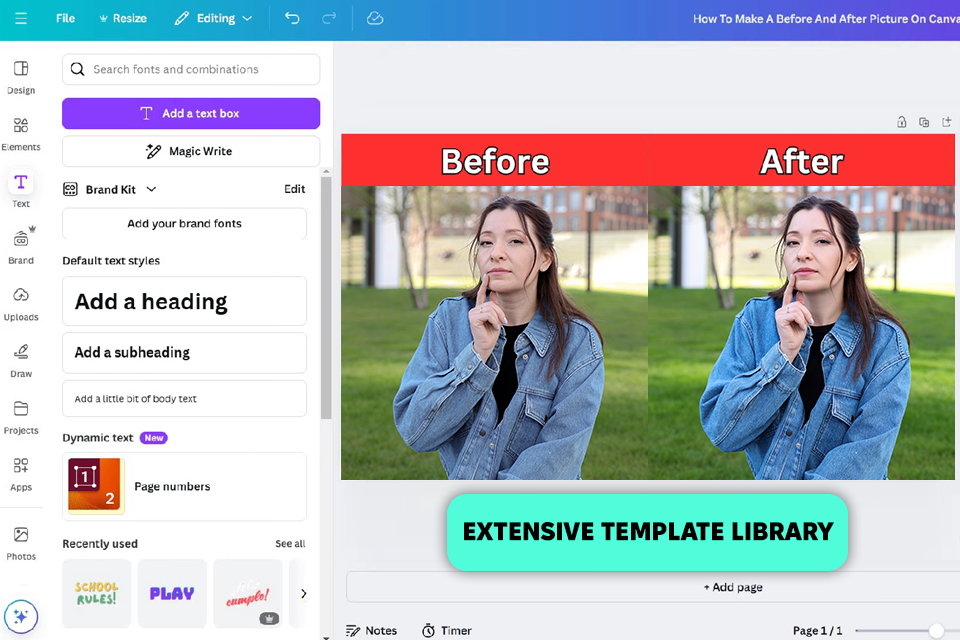
Distinctive features:
Price: Free or $120/year
Compatibility: web, Windows, macOS, Android, iOS
You’ve probably heard about Fotor vs Canva competition. Two programs really have some features in common, like templates, drag-and-drop performance, basic photo editing, AI-powered tools, and cloud access. However, their main specializations are different, with Canva being primarily focused on collaboration and design versatility.
Fotor has a neat interface with lots of tools. Such a layout may confuse beginners slightly. Canva is a more user-friendly alternative to Fotor with streamlined navigation, understandable tabs, and menus.
I decided to compare these programs by editing a portrait. In Fotor, I used the AI Retouching tool. Canva has special Photo Effects. Generally, Fotor offers better control over skin smoothing and lighting. Besides, the processes were fast thanks to AI mechanisms.
Canva excels at quick tweaks. My colleague Kate checked real-time collaboration features. She worked on presentation templates in Canva together with other guys. She liked shareable links, the possibility to assign roles, and working on slides together. Doing that in Fotor isn’t possible.
We also used templates for making social media posts. Canva photo editor transcends Fotor in terms of customization. You can change almost everything. This is a wonderful solution for designers. Still, Fotor comes out on top for photo editing tasks. Thanks to its AI tools, you can achieve great results promptly.
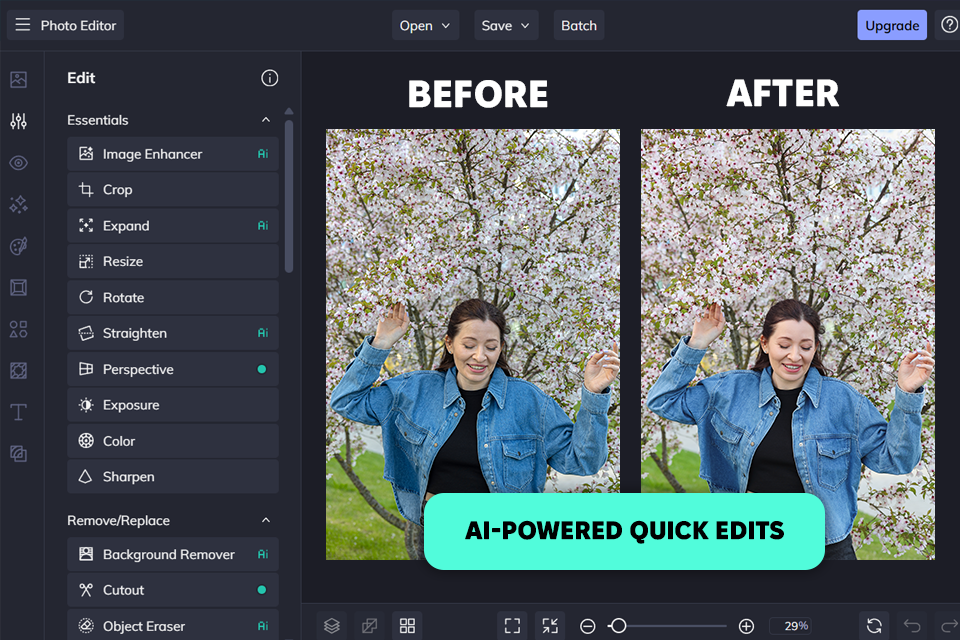
Distinctive features:
Price: Free or $14.99/mo
Compatibility: web, Android, iOS
Fotor and BeFunky both offer tools for cropping, resizing, adding text, and batch image processing. They also use AI to enhance photos and remove backgrounds. Such automation is advantageous for beginners. Still, when comparing Fotor vs BeFunky, the latter is more user-friendly.
However, if you're looking for more advanced features to tweak and personalize your photos, BeFunky may lack capabilities compared to Fotor. But neither one has built-in tools for real-time cooperation. A nice advantage of this Fotor AI alternative is that it links up with Pixabay and Pexels, giving you access to a huge collection of free images. Fotor is less appealing in this regard.
The thing I like about BeFunky is its one-click corrections. My colleague Kate is particularly pleased with Collage Wizard in BeFunky. She managed to arrange multiple photos into an eye-pleasing visual display. Fotor is less helpful for such tasks. Kate also likes cartoon and sketch effects on BeFunky photo editor, even though it is impossible to personalize them.
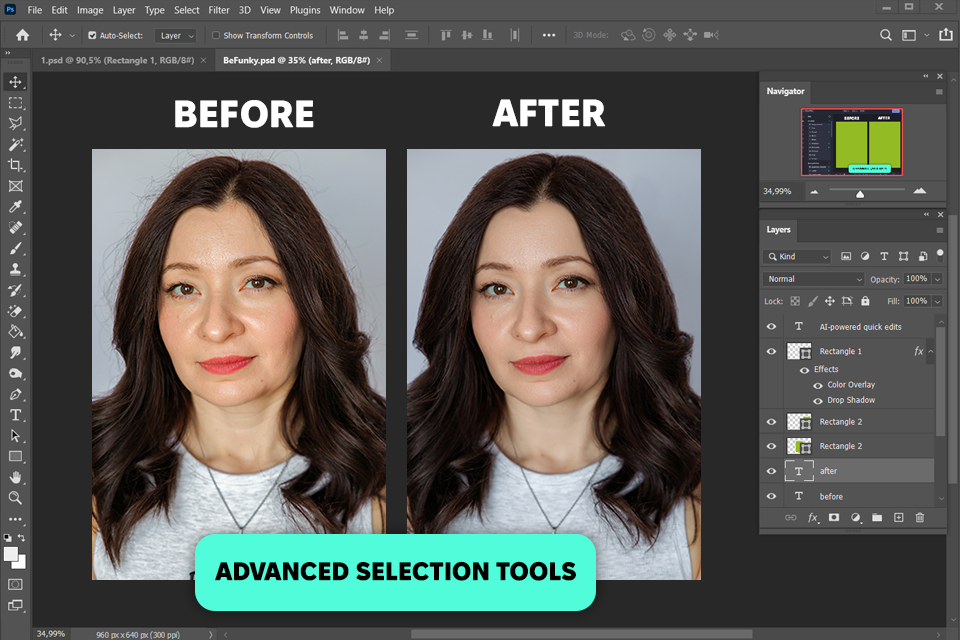
Distinctive features:
Price: 7-day free trial or $22.99/mo
Compatibility: Windows, macOS, iPadOS, iOS
When comparing Fotor vs Photoshop, both allow you to enhance your photos, using AI technologies, one-click effects, and remove backgrounds. Still, Fotor is a good option for simple touch-ups, while Photoshop is my choice when I need complete control over every tiny detail in my images.
Photoshop is packed with cutting-edge AI tools and is regularly upgraded. The latest update brought the new Remove Tool, which erases distractions without any traces, which is a challenge for Fotor. Moreover, there is the AI Text-to-Image feature, meaning you can generate the needed visuals right in the program. Fotor offers a similar possibility, but the process isn’t very smooth.
Moreover, you can take advantage of the Photoshop iPhone app to correct images on the go. The Fotor app feels more like a basic tool for quick fixes.
After testing this alternative to Fotor beauty editor, Kate says its AI portrait retouching tools are unmatched. When using Fotor, she noticed that the skin texture was spoilt. But when she switched to Photoshop professional photo editing software for PC, the results were amazing. Thanks to the AI-powered Select Subject feature, even small details remained polished and lifelike.
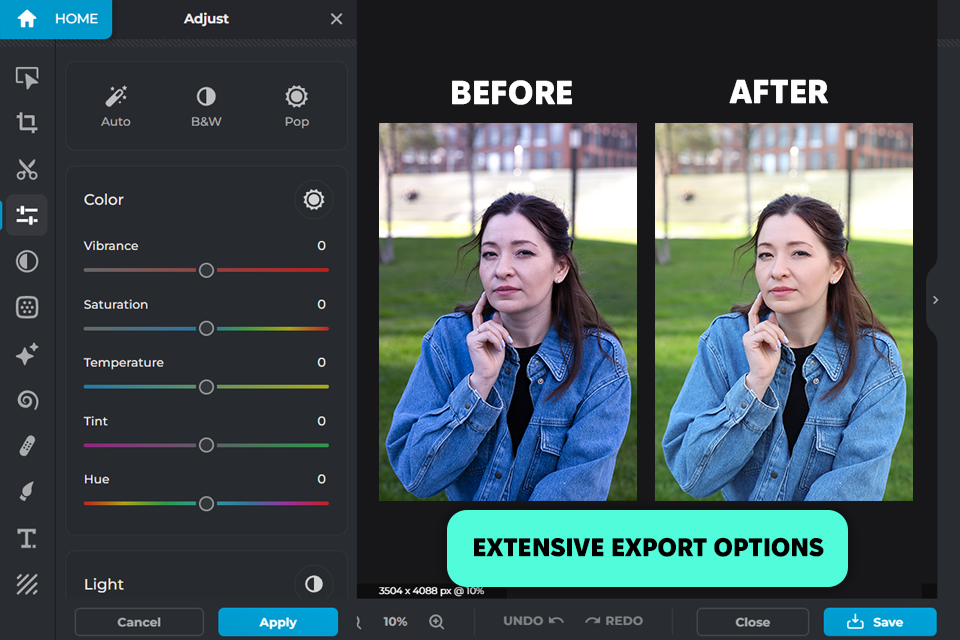
Distinctive features:
Price: Free or from $2.49/mo
Compatibility: Web, Android, iOS
Pixlr is a wonderful Fotor free alternative for anyone looking to integrate AI tools into their workflow. The program offers modern instruments for quick edits and design creation, neatly arranged on a user-friendly interface. Fotor, on the other hand, boasts efficient categorization tools.
Both Pixlr and Fotor are equipped with top-notch AI tools for quick and easy photo editing, like tools to automatically remove backgrounds, improve your pictures, and fix color irregularities. This is great if you want professional-looking photos quickly without needing to tweak everything by hand.
When it comes to background removal, you can use the AI Cutout tool in Pixlr or a background remover in Fotor. They both cope with the task well, giving you a proper base for collages or product photos. As for portrait editing, I tested AI adjustments in Pixlr. I liked the results as skin tones and details were accurate and realistic. Fotor’s Portrait tool is equally helpful for such tasks.
For joint photo editing work, you'll need to look beyond Pixlr and Fotor. While they both allow sharing files, neither makes it possible for multiple people to edit an image at the same time.
When comparing Pixlr and Fotor in terms of AI features, Pixlr is good for quickly fixing color issues, while Fotor has a unique AI Art Generator that can turn your photos into artistic creations. Pixlr lacks this feature. Kate believes that Pixlr is useful for quick, basic AI fixes. But if you're focused on editing selfies, Fotor's AI selfie editor is superior.
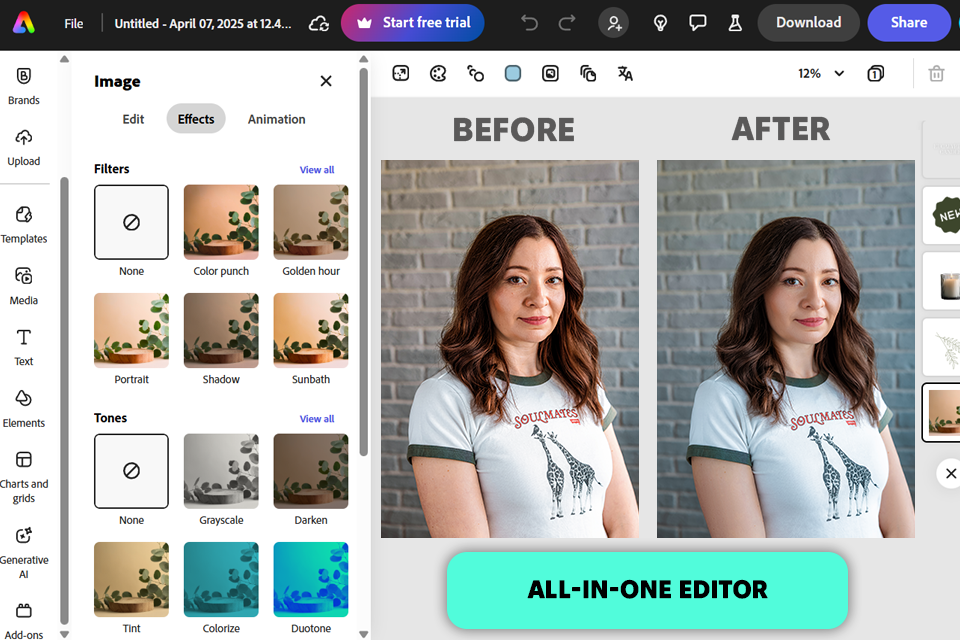
Distinctive features:
Price: Free or from $9.99/mo
Compatibility: Web, Windows, macOS, Android, iOS, iPadOS
You can use Adobe Express instead of Fotor if you are searching for an efficient AI-based program for design work. I tested the software by creating a post for social media and compared my experience with what I usually have in Fotor. As for AI capabilities, juxtaposing Adobe Express vs Fotor is easy, as they both automatically tweak brightness, sharpness, and saturation.
The distinctive characteristic of Adobe Express that gives it an upper hand over Fotor is extensive integrations. For example, when using Adobe Express, you can import photos right from Lightroom. This is a time-saving option many photographers will appreciate.
Express can do even more now thanks to the latest updates. You can convert your InDesign files to work on them in Express, arrange information in tables, make charts, change the color of images in one click, and resize your designs for any social media site instantly. Fotor lacks such tools. What’s more, the company has released Adobe Express for iPad, so your possibilities become boundless.
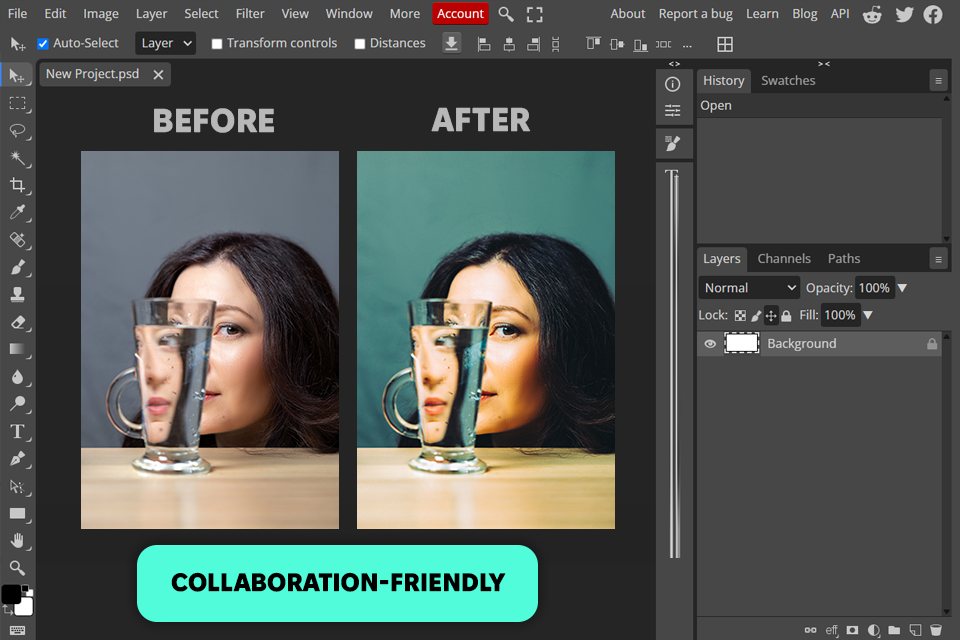
Distinctive features:
Price: Free or from $9/mo
Compatibility: Web
One more program that you can use as a free Fotor alternative is Photopea. It is a great web-based photo editor with tools for quick fixes. I needed to make a social media post and compared how both programs coped with the task. In Fotor, I selected a suitable template, customized colors, and added text. In Photopea, I had better manual control, so I tweaked layers and used blending modes.
When it comes to editing photos, Photopea provides better flexibility. Fotor is excellent for making fast edits and has some helpful AI features. Photopea lets you use layers, masks, and blending modes. It surpasses Fotor in terms of smart selection and content-aware fill. Plus, Photopea handles a wider range of formats, including PSD, AI, and RAW, whereas Fotor sticks to JPGs and PNGs.
Kate said that Photopea has an interface similar to that of Photoshop. She likes it a lot. Besides, she is satisfied with the selection tool because she was able to delete an object from the background very accurately. Fotor’s AI removal sometimes leaves sharp edges.
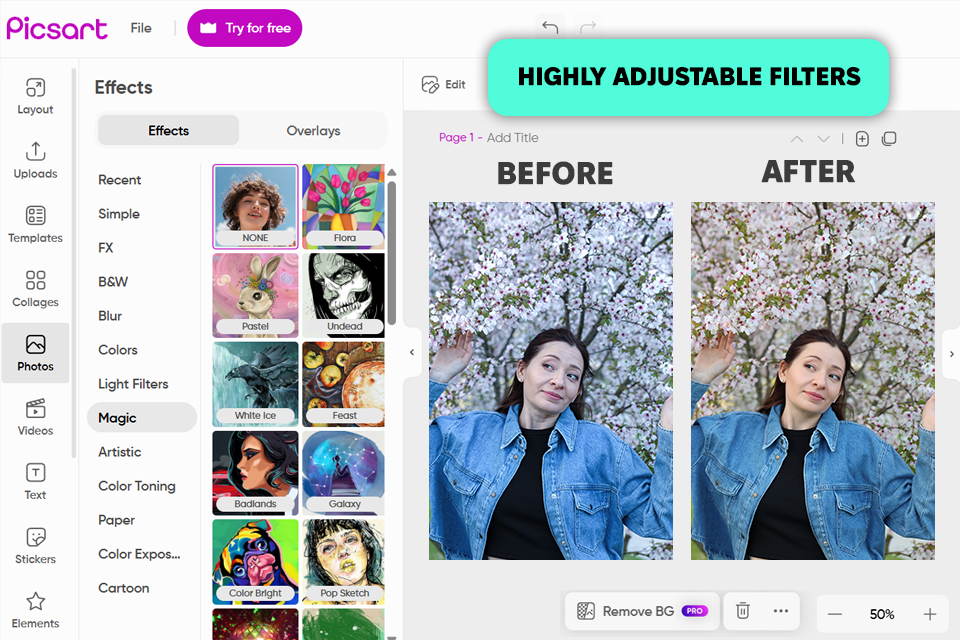
Distinctive features:
Price: Free or from $5/mo
Compatibility: Web, Windows, Android, iOS
PicsArt is one of the most popular free alternatives to Fotor. It stands out with a blend of AI tools and manual editing features. Just like Fotor, this free photo editing app is suitable for fast edits, touching up portraits, and adding fun, creative effects to your pictures. Both programs have simple interfaces, so you can easily find tools for cropping, adding text, and adjusting colors.
To my mind, PicsArt gives you more possibilities to be creative and personalize your photos compared to Fotor. One big difference is that PicsArt offers a huge selection of stickers, ready-to-use collage designs, and fun artistic effects. You can easily create pop art, adding bursts of color to your images, and more.
The HDR tool is also very useful. Using it, you can make dark areas brighter and accentuate the contrast. Another great feature in PicsArt is "Curves". With it, adjusting colors is a breeze. Fotor doesn’t offer a good counterpart. However, Fotor's AI tools are more “independent”. With PicsArt, you often have to adjust settings yourself.
I remember one project when I needed to improve the skin in PicsArt and had to move sliders very carefully to get a satisfying result. With Fotor, the process is easier thanks to autonomous AI tools. Also, PicsArt's skin smoothing feature doesn't always give the best results, so I need to fine-tune my edits. Kate used widgets and effects in PicsArt. She likes pop art and splash effects most of all.
There is a free version with basic functionality, simple templates, and design features. However, when you use the Fotor free version, you have to put up with certain restrictions. There are no advanced tools, unique templates, or watermark-free export. To get the most out of premium functionalities, you need to pay a subscription fee of $3.33/month.
Generally, there are lots of great programs similar to Fotor, and most of them have free versions with certain limitations. If you are willing to spend money, you can examine such programs as Canva, PicMonkey, and Adobe Express.
Yes. Such programs as Photopea, Photoshop, and Adobe Express support RAW image editing.
Beginners should consider Canva and BeFunky. They are user-friendly programs with multiple templates.
Yes, Canva, Pixlr, and Adobe Expres have a dedicated collection of templates designed in accordance with the requirements of Instagram, Twitter, and Facebook. You can choose a suitable template, customize it, and get a post ready for sharing in an instant.
To help our readers find the best photo editors like Fotor, we tested a wide range of options, both free and paid. We evaluated GIMP, PicMonkey, PicWish, Paint.NET, Luminar Neo, and many others to see which ones offered AI features for streamlined photo editing, good control over changes, and smooth workflow integration.
To discern the real capabilities and efficiency of every program, we used multiple photos for editing. The selection included portraits taken in different lighting, outdoor lifestyle pictures, RAW images, and more.
AI features. We checked how helpful each AI photo editor was for skin smoothing, color correction, and other frequent tasks. Surely, we paid special attention to the naturalness of outcomes.
Manual control. When using photo editors, it is important to have the possibility of manual tweaks. So, we checked the layer masks, frequency separation, Dodge & Burn features, and color grading.
Retouching quality. Kate was the one who assessed the quality of processed photos. She considered whether Fotor alternatives distorted skin textures, fixed lighting issues properly, and removed blemishes without traces.
Batch processing. Retouchers often need to edit multiple photos simultaneously. So, we picked only those programs that supported batch photo editing.
Speed & usability. A good photo editor should be easy to use from the first launch. Besides, it should cope with multiple tasks without freezes and lags. We picked tools that meet such requirements.
File support & export options. I checked whether Fotor's free alternatives could handle RAW, TIFF, and high-res PNG files. Kate examined the availability and accuracy of non-destructive photo editing. We also reviewed possible export options.
Web, mobile vs desktop experience. Currently, you can edit photos not only on computers but also on mobile devices. So, we wanted to find apps that ensure smooth image processing on the go. We checked synchronization across devices, ease of switching, and the quality of outputs.